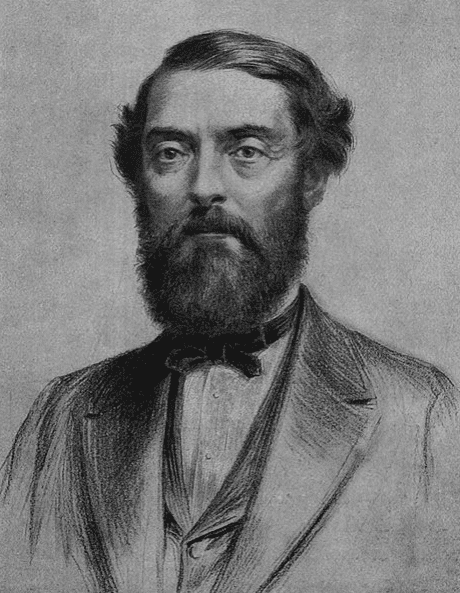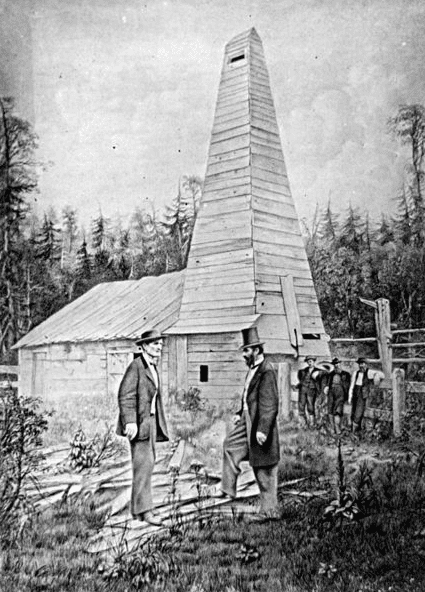News about oil drilling, the price of gasoline, and the petroleum industry in general often dominates today’s headlines. It may surprise some people, however, to learn that the oil drilling industry made big headlines way back in 1859 – when the first commercially successful oil well was drilled. On 27 August 1859, Edwin Laurentine Drake (1819-1880) drilled that well near Titusville, Pennsylvania, beginning the Pennsylvania oil rush of the second half of the 19th century.

Many people equate the petroleum industry with gasoline, and assume the industry – along with the automobile industry – were features of the 20th century. However, petroleum was sought in the 19th century as a replacement for whale oil, used in lamps to light people’s homes.
Drake was working for the newly-formed Seneca Oil Company when he made his discovery. He used a steam engine to power his drill, and his great innovation was to line the hole with cast iron pipe and drill through the pipe down below the bedrock. The pipe prevented the deep hole from collapsing in on itself. This became known as the “Drake Well” method, a system essentially still used today. Drake’s drill bit found oil at a depth of 69.5 feet.

Titusville was a sleepy little town of 250 residents when Drake made his discovery, but that all changed very quickly. The town’s population swelled to 10,000, as eight oil refineries were built between 1862 and 1868 and oil industry support businesses mushroomed.
Jonathan Watson, the man lucky enough to own the land where Drake was drilling, became history’s first oil millionaire. There was lots of money to be made in Titusville, and Watson was soon followed by a host of oil millionaires.
Edwin L. Drake, however, was not one of them. Lacking good business sense (including failing to patent his innovative drilling invention, the “Drake Well”), he went broke in 1863 and never recovered financially. In 1872 Pennsylvania took pity on the man who almost single-handedly founded the state’s lucrative oil industry and granted him an annuity of $1,500, which he lived on the remaining eight years of his life.
The correspondent of the article below, who identifies himself as “Medicus,” was in California when that state’s gold rush began in 1849 – and reports the Pennsylvania oil discovery is causing just as much excitement.

Here is a transcription of this article:
Discovery of a Subterranean Fountain of Oil.
Correspondence of the New York Tribune.
TITUSVILLE, Penn., Sept. 8, 1859.
Perhaps you will recollect that in 1854 there was organized in the city of New York a company, under the name of the Pennsylvania Rock Oil Company, which, for some good reasons, passed into the hands of some New Haven capitalists, and was by them removed to New Haven. In 1858, the directors leased the grounds and springs to Mr. E. L. Drake, well known on the New Haven Railroad. He came out here, and in May last commenced to bore for salt, or to find the source of the salt, which is so common along the banks of Oil Creek. Last week, at the depth of 71 feet, he struck a fissure in the rock through which he was boring, when, to the surprise and joy of everyone, he found he had tapped a vein of water and oil, yielding 400 gallons of pure oil to every 24 hours (one day).
The pump now in use throws only five gallons per minute of water and oil into a large vat, when the oil rises to the top and the water runs out from the bottom. In a few days they will have a pump of three times the capacity of the one now in use, and then from ten to twelve hundred gallons of oil will be the daily yield.
The springs along the stream, I understand, have been mostly taken up or secured by Brewer & Watson, the parties who formerly owned the one now in operation.
The excitement attendant on the discovery of this vast source of oil was fully equal to what I ever saw in California, when a large lump of gold was accidentally turned out.
— Medicus
Note: An online collection of newspapers, such as GenealogyBank’s Historical Newspaper Archives, is not only a great way to learn about the lives of your ancestors – the old newspaper articles also help you understand American history and the times your ancestors lived in, and the news they talked about and read in their local papers.
